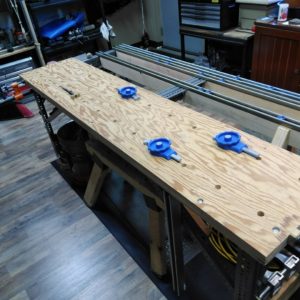Epoxy finish for a benchtop with dogholes in it already
I’m working on a woodworking/metalworking/whatever workbench, and I’d like to coat the woodworking side’s top with 2-part bar-top epoxy. This benchtop already has the dog-holes in it. Any ideas or tried techniques for temporarily plugging or blocking the dog-holes so a pour of the epoxy will neither clog nor run out of the dog holes?
Thanks!
















Replies
Epoxy will not stick to Saranwrap so you could turn some tapered dowels , wrap them and hamer them in the holes. You could also use modeling clay, scrape the excess flush with the top and clean-up afterwards.
Probably not what you're looking to hear, however, if you do any substantial pounding on the top the soft plywood will deform under the epoxy and likely separate. This will happen when you stress those dog holes also. The epoxy will be a pretty rigid layer over a fairly soft substrate.
You really don't want a work bench top too slippery, either. Bartop finish will have work sliding all about. I would leave it unfinished.
If you do want it finished, try oils. Tung oil or Danish oil are penetrating oils. They don't sit on the wood & won't chip or break.
If you insist on epoxy, let it run through the holes and drill them out when it dries. But, you should listen to John's sound advice.
Mikaol
Why would anyone want to do this?
Listen to MJ, John and Mikoal or you will be extremely unhappy with the performance of your new bench.
There are a wide variety of sizes of conical shaped rubber stoppers available. I just purchased three of them in sizes from 1/2" to 1 1/4" (major diameter). Bought them at our local store that sells scientific items like microscopes, etc. Should be on the e-bay, Amazon, etc., as well.
Epoxy? Won't that stick like...epoxy to anything used to fill the holes?
Sounds like a long frustrating cleanup job.
The people recommending against this are offering good advice.
Have you considered wax? Perhaps in a small area to test the results?
Because the rubber stoppers are conical, you just push them into the dog holes (maybe tap them with a hammer once to make sure they are seated) and they will seal extremely well. When the epoxy is dry, just tap them once to unseat and remove them.
This forum post is now archived. Commenting has been disabled